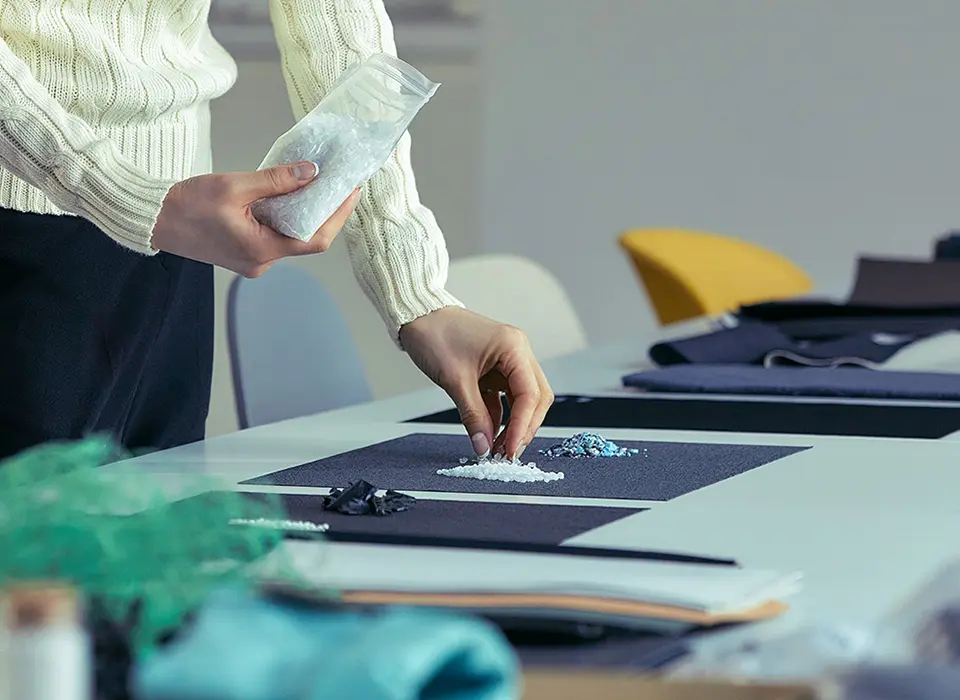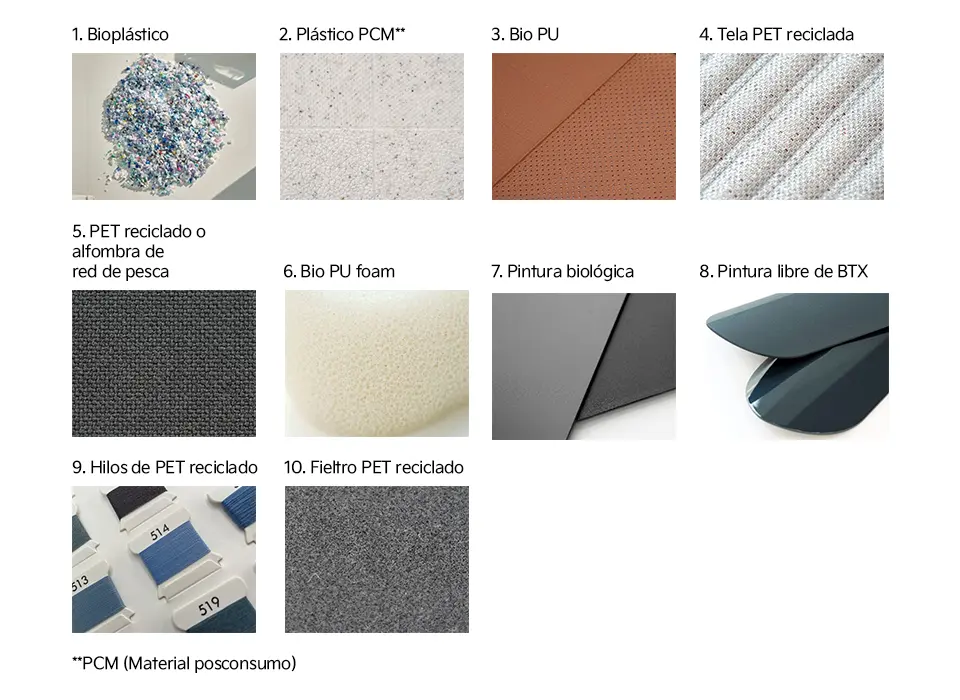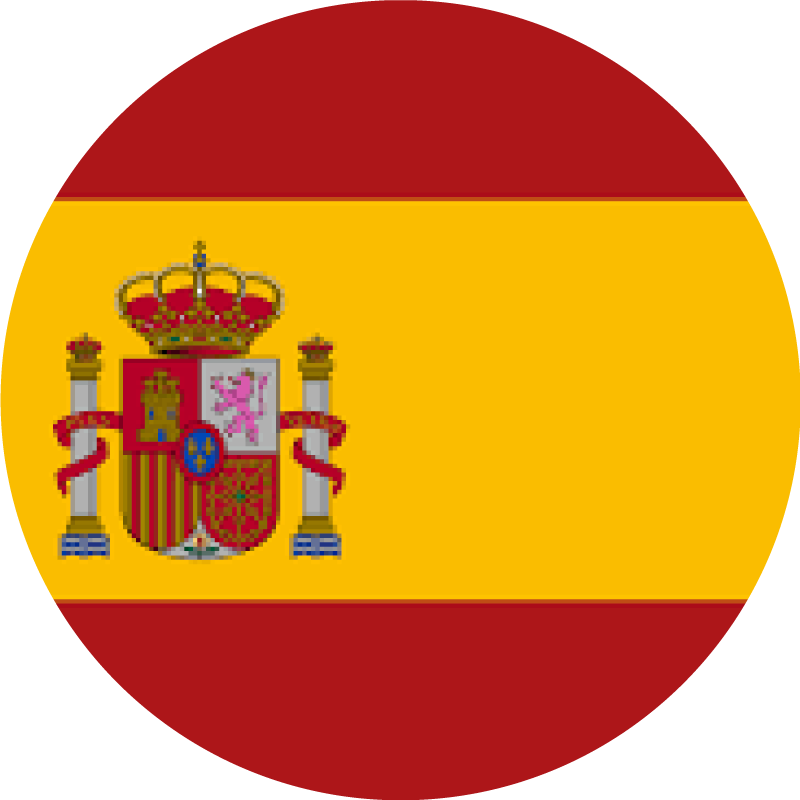Responsible Material Design
Responsible Material Design
20 May, 2024
Kia takes a bold step towards sustainability
- Kia’s 10 sustainability must-haves will be applied to all new Kia model lines, with the aim of achieving sustainability on a large scale.
- The policy is part of Kia’s Design Sustainability Strategy, which includes commitments to phase out the use of leather and invest in the development of new bio-based materials.
- Kia aims to reduce carbon emissions in the near term and achieve carbon neutrality across all its operations by 2045.

Kia has revealed new details of its ’10 Sustainability Must-Haves’, which define a foundation for the use of sustainable materials in its future model lines.
Kia has a long history of integrating sustainable materials into its products, starting with the use of bioplastic and sugarcane biofibre in the 2014 Soul EV. Kia has continued to pursue sustainability in its products, with the current range of plant-based components and the use of recycled PET and discarded fishing nets in the production of its fabrics and carpets.
Now, as a step towards achieving the brand’s goal of carbon neutrality across all its operations by 2045, Kia has announced further details of its overall Sustainability in Design Strategy. The initiative aims to achieve sustainability on a large scale, while providing the best material solutions for all new model lines.
The first measure has been Kia’s firm commitment to completely eliminate the use of leather in all new products. The second, detailed below, will involve integrating its 10 sustainability must-haves into its new model lines, starting with the EV9. Finally, as part of its advanced efforts, Kia will continue to invest in testing and development programs to accelerate the implementation of bio-manufacturing, underscoring its dedication to promoting sustainable technologies.
10 essential sustainability elements in the EV9
These are 10 material solutions such as Bio PU, recycled PET fabric and BTX-free paint that will be applied to the new Kia models, which will contribute to reducing the impact on the environment.

1. Bioplastic
Bioplastics are an interesting and innovative type of plastic that can be produced from a variety of renewable biomass sources, such as vegetable oils, corn extract, sawdust, and sugar cane. Using bioplastics not only helps reduce dependence on fossil fuels, but also offers the added benefits of a diversified source and reduced exposure to unwanted chemicals.
In addition to its sustainability, bioplastic is also versatile and durable enough to be used in various components of the car’s interior. From the dashboard and console to the pillars and trim, bioplastic can be found incorporated throughout the EV9’s design.
2. Post-Consumer Plastic Material (PCM)
Post-Consumer Plastic (PCM) is precisely what it sounds like: plastic made from recycled material from existing products rather than new, ‘virgin’ pellets.
This revolutionary process has several advantages that span the entire production lifecycle. Firstly, it significantly reduces the amount of plastic waste that ends up in landfills or polluting the environment. Secondly, post-consumer recycled plastic also helps conserve non-renewable resources by reducing the need to use virgin materials in the creation of new products.
One of the key areas where PCM plastic has been incorporated into the new Kia EV9 is the door trims. Kia’s integration of post-consumer recycled plastic into the construction of the EV9 is a proactive step that contributes to waste reduction and landfill regeneration.
3. Bio-based PU
In its efforts to phase out leather, Kia identified Bio-based Polyurethane (PU) as the optimal solution, given its potential to reduce overall carbon emissions and incorporate plant-based components, ultimately contributing to a more sustainable balance.
Not only does Bio-based PU offer a sustainable alternative, it also offers a comfortable seating experience. Carefully engineered to provide excellent support, cushioning and durability, as well as a soft, breathable feel, Bio PU can be found in the seats and interior trim of the new Kia EV9.
4. Recycled PET fabric
Polyethylene terephthalate (PET) is one of the easiest plastics to recycle in the world, making it ideal for a variety of sustainable applications, from water bottles to clothing.
With good resistance to impact, moisture and solvents, it is the ideal fabric to cover exposed surfaces in the car’s interior. Kia has taken it a step further by using recycled yarn to partially compose its PET fabric, ensuring both sustainability and durability in the interiors of the new Kia EV9.
This material can be found in numerous areas of the EV9’s interior, including the seats, headliner, sun visor, trim and headrests. Notably, each EV9 incorporates at least 70 recycled bottles, highlighting the brand’s commitment to reducing waste.
5. Recycled PET carpet
In addition to its presence throughout the rest of the cabin, Kia uses 100% recycled PET in the creation of its standard carpets. Going further, the brand offers the option for a portion of this material to be sourced from recycled fishing nets.
This is not just an innovative use of waste, but also addresses the serious problem of discarded and lost fishing nets that devastate marine life around the world. Around 640,000 tonnes of fishing gear ends up in the oceans every year, resulting in the deaths of countless marine creatures including seabirds, whales and seals.
By capturing and recycling ghost nets, Kia is not only working to mitigate the entry of plastic particles into the water as they break down, but also to limit the impact they have on the crucial ecosystems of our oceans as a whole.
The cabin floors of the new Kia EV9 feature carpets made from recycled PET and fishing nets.
6. Bio PU foam
Polyurethane (PU) foam is a versatile material that can be used in sporting goods and space shuttle insulation. Its excellent durability and compression characteristics also make it an ideal choice for cushioning in a wide range of applications, such as furniture, bedding and footwear.
Manufactured with the help of natural oils, Kia’s Bio PU foam offers the strength and flexibility of standard polyurethane with a reduced impact on the planet.
Bio PU foam can be found in the headrests of the new Kia EV9.
7. Bio-based paint
Bio-based paint is more sustainable than alternatives made from crude oil and reduces chemical waste that typically results from the manufacturing process.
Kia’s bio-based paint is made from rapeseed oil, a vegetable oil derived from rapeseed and commonly used in the food, biofuel, paint, cosmetics and pharmaceutical industries.
Bio-based paint can be found on the door switch panels of the new Kia EV9, minimising environmental impact without compromising quality.
8. BTX-free paint
Kia has proactively addressed the harmful environmental effects associated with using the combination of benzene, toluene and xylene (BTX) by adopting a sustainable solution: BTX-free paints.
By applying BTX-free paints to its models, the brand offers the same high-quality protection and finish that customers expect, whilst minimising the use of polluting chemicals.
In line with its commitment to sustainability, the new Kia EV9 features an interior that is adorned with BTX-free paints almost everywhere, with the exception of the door window switch panel, which is coated with bio-based paint.
9. Recycled PET yarn
Polyethylene terephthalate (PET) once again demonstrates its versatility – the yarn used for certain interior applications in Kia models is made from 100% recycled PET bottles.
Over 70 recycled PET bottles are used in all recycled PET items found in the new Kia EV9.
Among its many applications, recycled PET yarn takes centre stage in the stitching of the seats, adding an extra layer of sustainability to the EV9’s interior design.
10. Recycled PET felt
Felt made from recycled PET bottles is soft and durable – key qualities when used in an environment where everything from luggage to pets may be transported.
PET has the added benefit of offering good sound absorption, reducing sound transmission from the rear of the car to the rest of the cabin and helping to maintain a driving experience that feels as good as it looks. Recycled PET felt can be found in the luggage board of the new Kia EV9.






